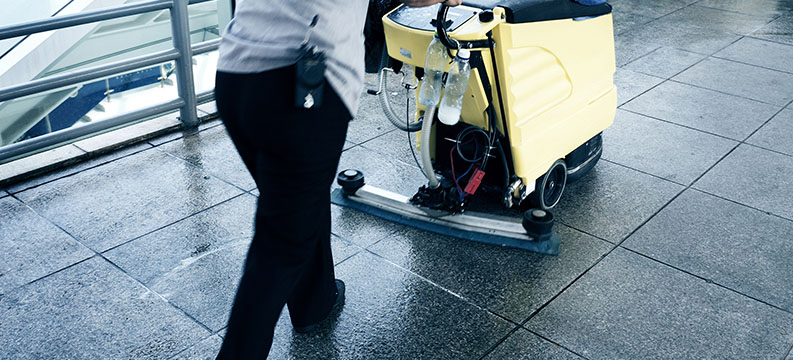No business knows better than one in the cleaning industry that labor is money. In fact, labor can consume up to 90 percent of a cleaning budget. And as most of us also know, floor care is one of the most labor-intensive tasks cleaning crews perform. With these facts in mind, below are 10 suggestions for lowering your floor care costs.
1. Choose the right products. Nothing is a bigger labor cost drain than discovering you used the wrong stripper, polish, sealer or other floor care product after the fact! To avoid wasting time and money (or having an even more disastrous outcome) it is vital to know what kind of products work on what types of floors. This starts with reading the manufacturer’s label. However, be on the alert for possibly over zealous claims since a product that “can” be used on a specific type of flooring does not necessarily mean it is the best one to use. If you are in doubt, check with your distributor and/or ask for recommendations from colleagues who maintain the same types of floors.2. Discover new formulations. Floor polishes have come a long way in the last few years alone. Not only are there many non-toxic and VOC-free offerings (which can reduce potentially expensive labor health-related issues) but there also are new formulations that incorporate nanotechnology. Highlights of these finishes include fewer coats; increased square-foot coverage; faster drying times; and a harder, durable finish that is more dirt, water, scratch and scuff resistant—all of which can add up to huge labor savings.
3. Embrace technology. Today’s autonomous floor machines are one example of the labor savings “smart” technology offers when it comes to floor care. These machines use lasers and software to map the floor layout, including furniture and other potential obstacles, in a single pass. From this they can accurately predict square footage, product requirements, average time and other factors aimed at completing the job with minimal human labor. Most come complete with accuracy, maintenance, scheduling, product-usage, battery- level and other reporting functions that remove the guess work and further free up workers’ time.
Another example of labor-saving technology is industry-specific software. These programs contain a multitude of options that can help reduce floor care labor, including work-loading, scheduling, automatic maintenance reminders, project tracking—even accountability reports that can help keep workers focused and inspired to produce quality floors in a reasonable timeframe.
4. Choose microfiber. Microfiber mops hold and retain more dirt and water than traditional string and other types of mops, which reduces the number of passes required to clean floors as well as to pick up unwanted moisture. Reusable microfiber mops also can be laundered for up to 200 times. (Single-use microfiber mops might be preferred in health care settings to avoid even a trace of cross contamination.)
5. Buy in bulk. Most suppliers offer appealing discounts for buying sealer, finish, and other floor care formulas in larger containers and quantities.
6. Join forces. Consider joining a buying group—or create your own group of colleagues—to receive the larger discounts associated with volume purchases.
7. Don’t defer maintenance. Floor machines and other floor care products should be treated the same as you would your car: Don’t wait until the unit breaks down and is out of commission. Perform routine maintenance as suggested by the manufacturer; if you hear an unfamiliar noise, check it out before a potentially small problem becomes a big one, requiring expensive repairs, or worse, replacement.
8. Buy quality. We’ve all heard it before, but the maxim “you get what you pay for” remains as true in floor care as elsewhere. A quality floor finish, for example, will require fewer coats, look better and last longer, which adds up to less frequent stripping and finishing—and considerable labor and product savings.
9. Train properly. Don’t subscribe to the trial—and error—method of training employees when it comes to floor care as it can prove an expensive mistake. Invest in your workers with formal coursework and hands-on demonstrations. Have new employees shadow your floor care experts. The training doesn’t have to be expensive. Most distributors and manufacturer representatives are happy to help with online and in-person training. All you have to do is ask.
10. Watch out for traffic. Is there a sufficient number of floor mats inside and outside doorways to catch dirt and debris before it scratches and scuffs the floor’s finish? Are you using a more durable finish in high-traffic areas? Are you performing routine maintenance more frequently in areas where traffic is heaviest? Watching the flow of traffic and taking suitable precautions can make floors last up to twice as long—and cut labor significantly.
Floor care often accounts for the largest chunk of a cleaning crew’s labor, but following these suggestions can keep it from orbiting out of control.



